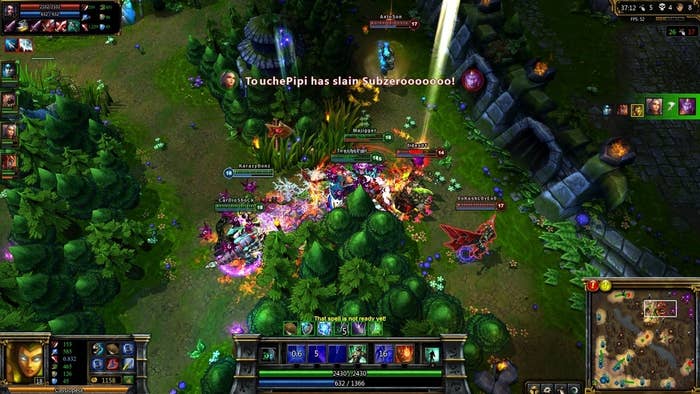
You can learn a lot about someone, not least their age, by asking which shooter they played in college. Late 90s students crowded around N64s for bout after bout of Goldeneye; early and mid 2000s students took advantage of college LANs to wile away hours in Halo and its sequels; students of the past five years, with access to high speed internet and Microsoft and Sony's matchmaking networks, gravitated towards the ascendant Call of Duty franchise. The story of competitive gaming in dorm rooms for the past decade and a half has been the story of the shooter.
But that might be changing. Today, not even Activision's behemoth franchise can hold a candle—in terms of sheer player participation—to Riot Games' League of Legends, which, with over 70 million registered players and 32 million monthly gamers, is the most-played game in the world. League of Legends is a MOBA (Multiplayer Online Battle Arena), an exploding online multiplayer genre, and the game is well-represented on college campuses. While Riot hasn't released exact numbers, 60 percent of LoL players are either currently enrolled in or have completed some college. Add to that number the fact that 85 percent of LoL players are between 16 and 30 and it seems fair to speculate that a significant percentage of the game's audience are current college students. There's no way to directly compare the number of college students playing, say, Black Ops 2 and LoL, but the latter is clearly growing, and the former has consistently undersold its predecessor, Modern Warfare 3. And nothing better symbolizes the foothold of Riot's game in institutions of higher education than the grassroots campus organizations that have grown up around the game. IvyLOL is a student-run collegiate league that holds an annual tournament (it's been won in each of its first two years by a club from the University of California at Irvine.) And there are dozens and dozens of campus LoL clubs.
Now, these college LoL-ers have official support. This year, Riot opened their collegiate program, which lends organizational and logistical support (and swag) to registered college clubs. Riot started the program because of a growing sense, augmented by internal research, that colleges were swarming with LoL-ers who might have trouble finding each other. Says program coordinator Steve Jaworski, "League fans had started organizing on their own, but there were still so many collegiate players that didn't know how to get in touch with other players at their school. Solving that problem and centralizing players at each school became the main objective of the program."

It's very much in Riot's interest to know who plays their game, and where. Unlike the aforementioned shooters, League of Legends is free to play. Riot makes money on the game through several avenues: selling virtual items and special characters, selling broadcast rights for their immensely popular professional tournaments, and selling sponsorships to companies that want access to those millions of participant and spectator eyeballs. Because the financial model for the game feels much closer to broadcast television—a service more than a single-sale product—it makes sense that Riot would want extremely detailed metrics both internally and to show advertisers. And what do advertisers like better than 18-22 year olds?
Riot officially launched the college program in February, but has been consulting college clubs with an eye towards a comprehensive program since September 2011. At the time, Riot worked with about 30 campus clubs; now, according to Jaworski, the program counts hundreds of clubs at universities across North America. In addition, Riot's program has a backlog of several hundred club submissions that have yet to be evaluated and approved.
League of Legends has no single-player; it's a pure multiplyaer competition, and it is closely associated with the burgeoning eSports scene. As such it's a natural fit for campus and national competitions. And Riot has started supporting collegiate tournaments. In May 2012, Riot lent broadcast and technical support to the IvyLOL tournament final four in Austin; more than 1000 people attended. "Collegiate LoL reminds me a lot of college basketball," Jaworski says. "There are typically one or two standout players that can just go off in a game and carry their team. Players are also much more aggressive in their style than the professionals and it borders on reckless. This makes them so exciting to watch." The model, with occasional travel tournaments and a heavy social component, seems less akin to four guys sitting around playing Halo than to that standby of the modern college: intramural sports.
This Thursday and Friday, student reps from 20 of the top college clubs will gather at Riot's headquarters in Santa Monica for the first League of Legends collegiate summit. According to Jaworski, Riot will be collaborating with the club leaders across a variety of areas, from game design and art, to characters, to organized play and eSports. In addition to providing good campus PR, it can certainly be seen as a form of directed market research, a way of making sure that Riot's cash-cow service stays current for their young and valuable customers.
And Riot certainly has competition: Valve, the Washington company behind the Steam distribution service and the Half-Life series, officially released their own MOBA, called Defense of the Ancients 2, earlier this month. That's why it makes sense that Riot would want to establish campus institutions, to institutionalize their product before copycats catch up. So that, in ten years, alongside flag football and ultimate frisbee in the student center guide to campus activities, there's a listing for League of Legends.
